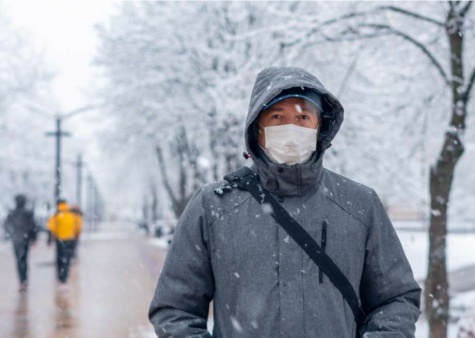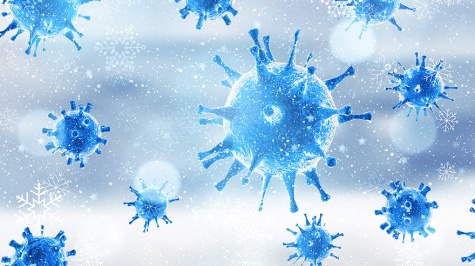
Reaghan Mulligan | Opinion Editor
December 9, 2020
After passing the spring, summer, and fall seasons of COVID-19, the prospect of entering our fourth season is daunting to some, while others seem to not be phased. With the official winter season beginning on December 21, scientists, politicians, and frankly anyone with an opinion have dished out their fair share of predictions for the pandemic. Will this winter prove to be a light at the end of the tunnel? Or will it be sending America into a dark and cold downward spiral? Unfortunately, many predictions are leaning towards the latter.
“We are entering what I think will be the worst stretch that we have experienced so far,” a John Hopkins Center for Health Security epidemiologist, Caitlin Rivers, said via a National Public Radio (NPR) article.
Cases in America have been rising, and will most likely continue to rise thanks to the recent Thanksgiving celebrations. While many people have been diligently staying inside, others are continuing to disregard any sort of caution or care and routinely gather in large groups without masks or social distancing.
With temperatures dropping, people are seeking warmth inside homes as well as businesses if they are open. These confined spaces become largely problematic the more people are in them, not to mention poor ventilation in practically every enclosed room. Restaurants located in harsh weather regions are facing problems in regards to where they will seat customers—if they even are open to any sort of dining in the first place. Citizens want to stay comfortable inside, but how closely associated will warmth and safety be in these upcoming months? People should be taking into deep consideration the general regulations and recommendations for staying safe, and possibly amplify those mandates during winter, when many states don’t have the luxury of year-round sun, and, therefore, outside activities like San Clemente does.
Don’t confuse this with an invitation to abandon caution, however, as the city of San Clemente needs to be diligent in its efforts to limit the spread. With the upcoming holidays and the immense number of citizens who feel an overpowering call to disregard mandates and fulfill their Christmas party fantasies, the prospect of having a merry little Christmas seems, unfortunately, out of grasp.

Unlike the springtime and early summer, where COVID infections tended to bubble in certain hotspots, the infections are now everywhere, thanks to time, a lack of social distancing, and the continuous push for loosening regulations. Now, more than ever, we need to limit social outings and exercise proper social distancing. Times are tough, but they will only worsen if society as a whole does not band together to fight this pandemic.
In New York, a previous hotspot for the virus, Governor Andrew Cuomo has recently addressed plans and goals for the upcoming winter, including keeping schools safely open and increasing testing availability. However, it is primarily up to residents and their behavior in regards to staying safe this season that will determine the outcome of the next couple months.
Along with citizens who have been purposefully ignoring any sort of government or doctor recommendations to be cautious, a new group of citizens are facing what has been deemed “pandemic fatigue.” People are getting tired of masks and social distancing, and are instead choosing to slowly fall out of the habit of gathering outside in limited groups. Understandably, the entire world is sick of this pandemic, but life is not normal right now, and none of us can expect “normal” to happen anytime soon.
“It’s more important now than ever that we are vigilant about taking these protective measures,” Rivers said.
On the bright side, according to Ali Mokdad, a professor and epidemiologist with the Institute for Health Metrics and Evaluation, the infection fatality rate is falling by thirty percent. Yet Mokdad predicts that with the close proximities of many people during the colder months as well as other factors involving the virus, this rate will rise again. Additionally, vaccine approval and production seem to be gaining more momentum as we approach the new year, giving some hope for a mass vaccination that can eventually establish herd immunity.
In the meantime, with infections on the rise, you can greatly reduce your risk by being vigilant and keeping to yourself for most of this season, despite the lure of large family gatherings and eventful holiday parties. “People should try and stick to smaller groups and continue to wear masks and practice social distancing,” junior Natalia Martucci said.
Contactless gift delivery, Zoom calls, Christmas movie marathons. The possibilities are endless on ways you can celebrate the season without coming in contact with those outside of your immediate bubble.
“I think going back to the lockdowns at the beginning of the pandemic might be best, and only going out when needed. Definitely no Christmas or New Years parties,” junior Samantha Shaw said. “It’s a pandemic, not a party.”
Home is where the heart is, but this holiday season, home should be where your immediate family—and the least amount of contact possible—is. With dropping temperatures and more indoor activities as we turn the corner into winter, it is vital to remember that the virus doesn’t hibernate. Just like the flu and most other colds, COVID will thrive during winter, when everyone is cozied up by the fireside or sharing hot cocoa in the living room.

Leave a Reply